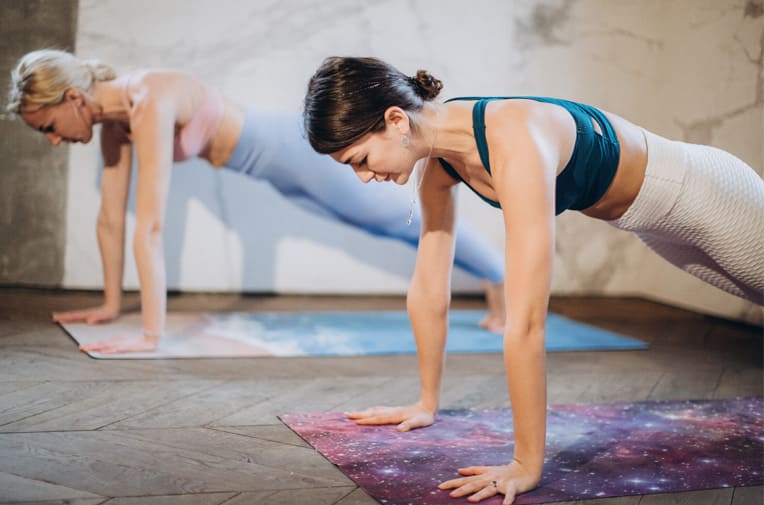
Chaturanga Dandasana is also known as the four-limbed staff poses and low plank pose. Pose in modern yoga, and is misunderstood by pushups. In Sanskrit “chatur” means four, “ anga “ means Limbs, and “ danda” means staff or spine. It is commonly used in Power Yoga sessions. In this pose, the body is in a plank position but with straight arms and palms under your shoulder. In this posture, the elbow is kept at the side of the body and the central part or torso is lowered to make 90 degrees with the arms. And legs are kept straight with toes pressing the floor. Chaturanga dandasana is linked with some other poses like downward-facing dog pose, upward-facing dog pose, and plank pose. It required a lot of strength in the arms, core, and shoulder. It improves the overall strength of the upper body and improves posture.
Benefits of Chaturanga Dandasana
It has several benefits for the mind and body. Some of them are-
- It strengthens the core muscles and muscles of the arms and shoulders. Practicing Chaturanga Dandasana, increase the engagement of arms, shoulder, and core muscles which improves the strength and stability of the upper body.
- Pose that builds the strength and flexibility needed for arm balances and inversions.
- It helps in improving posture- if we do this pose at regular time intervals, it helps in maintaining a good posture and reduces back pain and discomfort in the neck, shoulders, and upper back.
- Builds energy- it can increase stamina, and energy by holding a number of breaths at a time.
- To perform Chaturanga Dandasana , one needs a full body-mind to work together to maintain the posture which helps in improving body awareness.
Overall, Chaturanga Dandasana is a strong position that can help to improve stamina and get the body ready for more difficult postures. It can also help to strengthen the body, posture, and body awareness.
Steps to follow:
- Firstly, start with a plank pose and keep your hands straight with a gap between your palm which is facing downward, and make sure to keep your palm under your shoulder with feet hip-width apart. Keep your body straight from head to toe.
- Make sure to keep your elbow close to your sides and slowly bring your body down to the ground surface. Keep your shoulder away from your body and focus on the front.
- Slowly descend your body so that your arms form a 90-degree angle with your arms while attempting to maintain parallel upper arms with the floor.
- Hold this posture for a few minutes and keep your muscles engaged.
- Release the pose by lowering your body down to the floor or go back to the plank pose.
Beginners Tips:
- In starting participants face difficulties while performing chaturanga dandasana. The importance of doing this pose is to test your arms’ strength by using your whole arm, biceps, triceps, and elbow to make your arm more strong.
- If you are finding difficulty in starting don’t lose hope just practice it regularly, it takes time to strengthen your arms and core, to align your body properly.
- If you find it challenging in the beginning then start with the modified version. Slowly, build your strength then jump to the chaturanga dandasana pose.
- Start with a plank pose and keep in mind to engage your core.
- Follow the steps as guided, don’t be in a hurry to finish your asana. Just do it slowly and don’t burden your body.
Cautions
Here, are some cautions to take care of while performing a four-limbed staff pose-
- While performing the pose keep in mind that your shoulder doesn’t touch your ears. And don’t carry on the pose if you feel any strain on your shoulder.
- don’t lower your body too much. Keep your body still when your arm proper (brachium) is parallel to the ground surface. It can cause pain in the lower back.
- keep in mind that your hips don’t fall too much, keep them high while engaging your legs. If you lower your body too low, It can cause injury or strain in the shoulder and neck.
- Keep in mind to keep your elbow near your body especially near chest if your elbows are too far apart then it can cause severe pain or injury in your shoulders due to extra pressure on your shoulders.
- If you feel any discomfort while performing the pose leave it there only, don’t avoid signals your body is trying to give.
To master any pose you need to give a lot of time to your body. Never overburden the body cause that can cause severe injury to you. Doing pose correctly gives you a lot of benefits while doing it wrong can give you lifelong pain.
